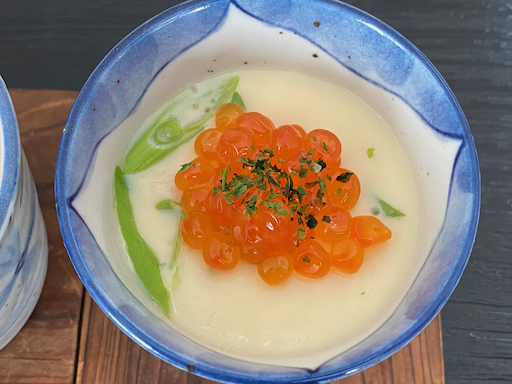On the Japanese food scene, it appears that any food which is rectangular in shape and has a soft texture is called "something"-tofu whether or not tofu actually makes an appearance as an ingredient. Dishes that actually include tofu would include the "
Avocado-tofu" I posted previously. However, "
Goma-dofu*" which is a signature appetizer at Sushi Taro does not include tofu at all. It is made of sesame paste and "kuzu" starch 葛粉. This is a foundation dish in Japanese vegan or "shoujin ryouri" 精進料理. It also made an appearance, as a vegetarian dish at a dinner we had many years ago, at a Buddhist temple "
shukubou" 宿坊 in
Koyasan 高野山. Then, there is a dish called "Gisei-dofu" 擬製豆腐, which means "pseudo" or "imitation"-tofu giving the impression that it does not include any "tofu". But, just to further confuse the issue, Gisei-dofu does, in fact contain tofu. So, bottom line; any dish with a name ending with "tofu" or "dofu*" may or may not contain tofu. Just to be crystal clear, the dish I posted here is called "tamago-dofu" 卵豆腐 and it does not contain any tofu, although the shape and texture closely mimics silken tofu.
*In the Japanese language, when a compound word ends in a noun starting with the letter "t" like "tofu", the first letter is replaced with "d" and becomes "-dofu" as in "goma-dofu" or "tamago-dofu".
In a perfect world, tamago-dofu should have a totally smooth surface but mine is not a perfect world. Some small bubbles and holes developed (called "su-ga-hairu" 巣が入る) as you can see in the above picture (the steam must have been too strong) but it still had a nice silky texture. It is often served cold with a bit of sauce and "Kinome" 木の芽, the young leaves of the Japanese pepper tree called "sansho" 山椒. Unfortunately, I do not have access to sansho (one of these days, I would like to have a Japanese pepper tree in my backyard). So, for this serving, I garnished it with dried nori or "aonori" 青のり.
This one I served it with a dab of real wasabi.
Tamago-dofu is essentially a firmer cousin of "
chawan-mushi". It is made with a mixture of seasoned broth and eggs but the ratio is 1:1.5-2 instead of 1:3-4.
Ingredients:
4 eggs (about 200 ml)
1.5 times seasoned dashi broth (about 300 ml), I made the dashi broth from dried kelp and bonito flakes and seasoned it with mirin, light colored soy sauce and salt. It should taste a bit stronger (saltier) than clear soup or "suimono" 吸い物.
Sauce: I mixed the dashi, light colored soy sauce and mirin to taste.
Special tool
Japanese stainless steal mold (mine is 7.2 x 7.2 inches or 18 cm, see composite picture #1). The insert lifts out for easy removal of the final product. You could also use a shallow rectangular loaf pan or baking dish but getting the final product out will be more difficult. I would prefer a smaller mold but this what I have.
Direction:
1. Beat 4 eggs and mix with the seasoned broth.
2. Pour the egg mixture through a fine sieve into the mold (#2). It is important to strain out all the
chalaza (thick proteinaceous material that is attache to both poles of the egg yolk). This is necessary to attain a silken smooth texture. This is the same when making chawan-mushi.
3. Place the mold in a steamer on low steam (If the steam is too strong the tamago-dofu, will develop holes. This is apparently what I did causing holes to form in this batch). Wrap the lid with a kitchen towel to prevent water condensation from dropping down on the surface of the egg mixture. Steam 25 to 30 minutes(#3).
4. Run a thin bladed knife along the edges of the pan and lift out the insert (#4) to make sure it is done.
5. I then put the insert back and covered the mold. I placed it in the refrigerator to cool.
6. Using a blunt edged knife (such as butter knife to prevent damaging the mold), cut the tamago-dofu into small squares (#5).
7. Using a small plastic spatula, remove each squares (#6) just before serving.
I am not sure if tamago-dofu is worth the effort but it did taste good with a nice texture. Of course, in Japan, this is readily available in individual plastic containers sold everywhere, even in convenience stores. I like chawan-mushi better but this can be served quite elegantly. I combined cubes of the tamago-dofu with cubes of silken tofu in a clear soup (I did not take a picture). The tamgo-dofu was yellow and more flavorful than the silken tofu but if you were not paying attention, it would be difficult to tell them apart. The consistency was almost identical. I may try again for a more perfect tamago-dofu.













































.jpeg)
.jpeg)



